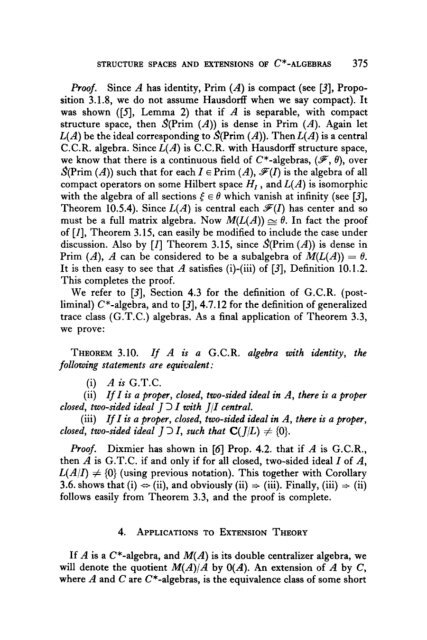On the Characters and the Plancherel Formula of Nilpotent Groups ...
On the Characters and the Plancherel Formula of Nilpotent Groups ...
On the Characters and the Plancherel Formula of Nilpotent Groups ...
You also want an ePaper? Increase the reach of your titles
YUMPU automatically turns print PDFs into web optimized ePapers that Google loves.
STRUCTURE SPACES AND EXTENSIONS OF C*-ALGEBRAS 375<br />
Pro<strong>of</strong>. Since A has identity, Prim (A) is compact (see [3], Proposition<br />
3.1.8, we do not assume HausdorfI when we say compact). It<br />
was shown ([S], L emma 2) that if A is separable, with compact<br />
structure space, <strong>the</strong>n S(Prim (A)) is dense in Prim (A). Again let<br />
L(A) be <strong>the</strong> ideal corresponding to $Prim (A)). ThenL(A) is a central<br />
C.C.R. algebra. Since L(A) is C.C.R. with HausdorfI structure space,<br />
we know that <strong>the</strong>re is a continuous field <strong>of</strong> C*-algebras, (9, fQ, over<br />
S(Prim (A)) such that for each I E Prim (A), F(I) is <strong>the</strong> algebra <strong>of</strong> all<br />
compact operators on some Hilbert space HI , <strong>and</strong> I,(A) is isomorphic<br />
with <strong>the</strong> algebra <strong>of</strong> all sections 5 E 8 which vanish at infinity (see [3],<br />
Theorem 10.54). Since I,(A) is central each g(I) has center <strong>and</strong> so<br />
must be a full matrix algebra. Now M&(A)) s 13. In fact <strong>the</strong> pro<strong>of</strong><br />
<strong>of</strong> [I], Theorem 3.15, can easily be modified to include <strong>the</strong> case under<br />
discussion. Also by [I] Theorem 3.15, since S(Prim (A)) is dense in<br />
Prim (A), A can be considered to be a subalgebra <strong>of</strong> M(L(A)) = 19.<br />
It is <strong>the</strong>n easy to see that A satisfies (i)-(iii) <strong>of</strong> [3], Definition<br />
This completes <strong>the</strong> pro<strong>of</strong>.<br />
10.1.2.<br />
We refer to [3], Section 4.3 for <strong>the</strong> definition <strong>of</strong> G.C.R. (postliminal)<br />
C*-algebra, <strong>and</strong> to [3], 4.7.12 for <strong>the</strong> definition <strong>of</strong> generalized<br />
trace class (G.T.C.)<br />
we prove:<br />
algebras. As a final application <strong>of</strong> Theorem 3.3,<br />
THEOREM 3.10. If A is a G.C.R. algebra with identity, <strong>the</strong><br />
following statements are equivalent:<br />
(i) A is G.T.C.<br />
(ii) If I is a proper, closed, two-sided ideal in A, <strong>the</strong>re is a proper<br />
closed, two-sided ideal J 3 I with J/I central.<br />
(iii) If I is a proper, closed, two-sided ideal in A, <strong>the</strong>re is a proper,<br />
closed, two-sided ideal J 3 I, such that C(J/L) # {O}.<br />
Pro<strong>of</strong>. Dixmier has shown in [6-J Prop. 4.2. that if A is G.C.R.,<br />
<strong>the</strong>n A is G.T.C. if <strong>and</strong> only if for all closed, two-sided ideal I <strong>of</strong> A,<br />
W/I) # {O} (using p revious notation). This toge<strong>the</strong>r with Corollary<br />
3.6. shows that (i) o (ii), <strong>and</strong> obviously (ii) 3 (iii). Finally, (iii) + (ii)<br />
follows easily from Theorem 3.3, <strong>and</strong> <strong>the</strong> pro<strong>of</strong> is complete.<br />
4. APPLICATIONS TO EXTENSION THEORY<br />
If A is a C*-algebra, <strong>and</strong> M(A) is its double centralizer algebra, we<br />
will denote <strong>the</strong> quotient M(A)/A by O(A). An extension <strong>of</strong> A by C,<br />
where A <strong>and</strong> C are C*-algebras, is <strong>the</strong> equivalence class <strong>of</strong> some short

















